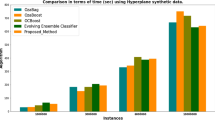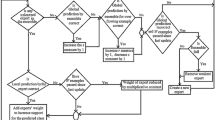Abstract
A novel online ensemble strategy, ensemble BPegasos (EBPegasos), is proposed to solve the problems simultaneously caused by concept drifting and the curse of dimensionality in classifying high-dimensional evolving data streams, which has not been addressed in the literature. First, EBPegasos uses BPegasos, an online kernelized SVM-based algorithm, as the component classifier to address the scalability and sparsity of high-dimensional data. Second, EBPegasos takes full advantage of the characteristics of BPegasos to cope with various types of concept drifts. Specifically, EBPegasos constructs diverse component classifiers by controlling the budget size of BPegasos; it also equips each component with a drift detector to monitor and evaluate its performance, and modifies the ensemble structure only when large performance degradation occurs. Such conditional structural modification strategy makes EBPegasos strike a good balance between exploiting and forgetting old knowledge. Lastly, we first prove experimentally that EBPegasos is more effective and resource-efficient than the tree ensembles on high-dimensional data. Then comprehensive experiments on synthetic and real-life datasets also show that EBPegasos can cope with various types of concept drifts significantly better than the state-of-the-art ensemble frameworks when all ensembles use BPegasos as the base learner.

Similar content being viewed by others
Notes
ASHTBag is excluded here since its ensemble strategy is dedicated to Hoeffding trees.
The scripts for generating these datasets are available at http://cs.nju.edu.cn/rl/people/zhaitt/datasetsGenerateScript.txt.
It can be downloaded from http://moa.cms.waikato.ac.nz/datasets/.
It can be downloaded from http://www.cse.fau.edu/~xqzhu/stream.html.
References
Abdulsalam H, Skillicorn DB, Martin P (2007) Streaming random forests. In: 11th international database engineering and applications symposium, pp 225–232
Abdulsalam H, Skillicorn DB, Martin P (2011) Classification using streaming random forests. IEEE Trans Knowl Data Eng 23(1):22–36
Abe S (2005) Support vector machines for pattern classification. Springer, London
Aggarwal CC, Yu PS (2008) Locust: an online analytical processing framework for high dimensional classification of data streams. In: Proceedings of the 24th IEEE international conference on data engineering, pp 426–435
Bifet A, Frank E (2010) Sentiment knowledge discovery in twitter streaming data. In: International conference on discovery science, pp 1–15
Bifet A, Gavalda R (2007) Learning from time-changing data with adaptive windowing. In: Proceedings of the 7th SIAM international conference on data mining, pp 443–448
Bifet A, Holmes G, Pfahringer B, Kirkby R, Gavaldà R (2009) New ensemble methods for evolving data streams. In: Proceedings of the 15th ACM SIGKDD international conference on knowledge discovery and data mining, pp 139–148
Bifet A, Holmes G, Kirkby R, Pfahringer B (2010a) Moa: massive online analysis. J Mach Learn Res 11:1601–1604
Bifet A, Holmes G, Pfahringer B (2010b) Leveraging bagging for evolving data streams. In: Joint European conference on machine learning and knowledge discovery in databases, pp 135–150
Bifet A, Holmes G, Pfahringer B, Frank E (2010c) Fast perceptron decision tree learning from evolving data streams. In: Pacific-Asia conference on knowledge discovery and data mining, pp 299–310
Bifet A, Pfahringer B, Read J, Holmes G (2013) Efficient data stream classification via probabilistic adaptive windows. In: Proceedings of the 28th annual ACM symposium on applied computing, pp 801–806
Brzeziński D, Stefanowski J (2011) Accuracy updated ensemble for data streams with concept drift. In: International conference on hybrid artificial intelligence systems, pp 155–163
Brzezinski D, Stefanowski J (2014a) Combining block-based and online methods in learning ensembles from concept drifting data streams. Inf Sci 265:50–67
Brzezinski D, Stefanowski J (2014b) Reacting to different types of concept drift: the accuracy updated ensemble algorithm. IEEE Trans Neural Netw Learn Syst 25(1):81–94
Demšar J (2006) Statistical comparisons of classifiers over multiple data sets. J Mach Learn Res 7:1–30
Denil M, Matheson D, De Freitas N (2013) Consistency of online random forests. In: Proceedings of the 30th international conference on machine learning, pp 1256–1264
Do TN, Lenca P, Lallich S, Pham NK (2010) Classifying very-high-dimensional data with random forests of oblique decision trees. In: Guillet F, Ritschard G, Zighed DA, Briand H (eds) Advances in knowledge discovery and management. Springer, Berlin, Heidelberg, pp 39–55
Domingos P, Hulten G (2000) Mining high-speed data streams. In: Proceedings of the 6th ACM SIGKDD international conference on knowledge discovery and data mining, pp 71–80
Elwell R, Polikar R (2011) Incremental learning of concept drift in nonstationary environments. IEEE Trans Neural Netw 22(10):1517–1531
Gama J, Fernandes R, Rocha R (2006) Decision trees for mining data streams. Intell Data Anal 10(1):23–45
Gama J, Sebastiao R, Rodrigues PP (2013) On evaluating stream learning algorithms. Mach Learn 90(3):317–346
Gama J, Zliobaite I, Bifet A, Pechenizkiy M, Bouchachia A (2014) A survey on concept drift adaptation. ACM Comput Surv 46(4):44
Holmes G, Kirkby R, Pfahringer B (2005) Stress-testing hoeffding trees. In: European conference on principles of data mining and knowledge discovery, pp 495–502
Hosseini MJ, Gholipour A, Beigy H (2015) An ensemble of cluster-based classifiers for semi-supervised classification of non-stationary data streams. Knowl Inf Syst 46:1–31
Hsu CW, Chang CC, Lin CJ, et al (2003) A practical guide to support vector classification. https://www.cs.sfu.ca/people/Faculty/teaching/726/spring11/svmguide.pdf
Katakis I, Tsoumakas G, Banos E, Bassiliades N, Vlahavas I (2009) An adaptive personalized news dissemination system. J Intell Inf Syst 32(2):191–212
Katakis I, Tsoumakas G, Vlahavas I (2010) Tracking recurring contexts using ensemble classifiers: an application to email filtering. Knowl Inf Syst 22(3):371–391
Kolter JZ, Maloof MA (2007) Dynamic weighted majority: an ensemble method for drifting concepts. J Mach Learn Res 8:2755–2790
Krempl G, Žliobaite I, Brzeziński D, Hüllermeier E, Last M, Lemaire V, Noack T, Shaker A, Sievi S, Spiliopoulou M, Stefanowski J (2014) Open challenges for data stream mining research. SIGKDD Explor 16(1):1–10
Lakshminarayanan B, Roy DM, Teh YW (2014) Mondrian forests: efficient online random forests. In: Advances in neural information processing systems 27: annual conference on neural information processing systems 2014, Montreal, Quebec, Canada, pp 3140–3148
Liu Y, Zhou Y (2014) Online detection of concept drift in visual tracking. In: International conference on neural information processing, pp 159–166
McCallum A, Nigam K et al (1998) A comparison of event models for naive bayes text classification. In: AAAI-98 workshop on learning for text categorization, vol 752, pp 41–48
Minku LL, Yao X (2012) Ddd: A new ensemble approach for dealing with concept drift. IEEE Trans Knowl Data Eng 24(4):619–633
Minku LL, White AP, Yao X (2010) The impact of diversity on online ensemble learning in the presence of concept drift. IEEE Trans Knowl Data Eng 22(5):730–742
Oza NC (2005) Online bagging and boosting. In: 2005 IEEE international conference on systems, man and cybernetics, vol 3, pp 2340–2345
Pappu V, Pardalos PM (2014) High-dimensional data classification. In: Aleskerov F, Goldengorin B, Pardalos PM (eds) Clusters, orders, and trees: methods and applications. Springer, New York, pp 119–150
Rutkowski L, Pietruczuk L, Duda P, Jaworski M (2013) Decision trees for mining data streams based on the McDiarmid’s bound. IEEE Trans Knowl Data Eng 25(6):1272–1279
Saffari A, Leistner C, Santner J, Godec M, Bischof H (2009) On-line random forests. In: 2009 IEEE 12th international conference on computer vision workshops, pp 1393–1400
Shalev-Shwartz S, Singer Y, Srebro N, Cotter A (2011) Pegasos: primal estimated sub-gradient solver for SVM. Math Program 127(1):3–30
Tomasev N, Radovanovic M, Mladenic D, Ivanovic M (2014) The role of hubness in clustering high-dimensional data. IEEE Trans Knowl Data Eng 26(3):739–751
Wang Z, Crammer K, Vucetic S (2012) Breaking the curse of kernelization: budgeted stochastic gradient descent for large-scale SVM training. J Mach Learn Res 13(1):3103–3131
Wang D, Wu P, Zhao P, Wu Y, Miao C, Hoi SC (2014) High-dimensional data stream classification via sparse online learning. In: 2014 IEEE international conference on data mining, pp 1007–1012
Ye Y, Wu Q, Huang JZ, Ng MK, Li X (2013) Stratified sampling for feature subspace selection in random forests for high dimensional data. Pattern Recognit 46(3):769–787
Zhang X, Furtlehner C, Germain-Renaud C, Sebag M (2014) Data stream clustering with affinity propagation. IEEE Trans Knowl Data Eng 26(7):1644–1656
Zliobaite I, Gabrys B (2014) Adaptive preprocessing for streaming data. IEEE Trans Knowl Data Eng 26(2):309–321
Zliobaite I, Bifet A, Read J, Pfahringer B, Holmes G (2015) Evaluation methods and decision theory for classification of streaming data with temporal dependence. Mach Learn 98(3):455–482
Acknowledgements
This work is supported by the National NSF of China (Nos. 61432008, 61503178), NSF and Primary R&D Plan of Jiangsu Province, China (Nos. BE2015213, BK20150587), and the Collaborative Innovation Center of Novel Software Technology and Industrialization.
Author information
Authors and Affiliations
Corresponding author
Additional information
Responsible editor: Thomas Gärtner, Mirco Nanni, Andrea Passerini and Céline Robardet.
Rights and permissions
About this article
Cite this article
Zhai, T., Gao, Y., Wang, H. et al. Classification of high-dimensional evolving data streams via a resource-efficient online ensemble. Data Min Knowl Disc 31, 1242–1265 (2017). https://doi.org/10.1007/s10618-017-0500-7
Received:
Accepted:
Published:
Issue Date:
DOI: https://doi.org/10.1007/s10618-017-0500-7




